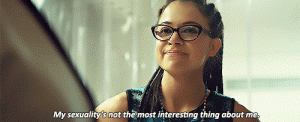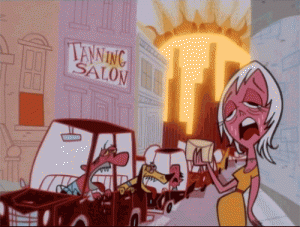Fun Home draws on both literary and visual elements to express a story. Without one or the other, the story would not be the same. The text and the visual draw on each other to enhance the story. In several instances, particular scenes contain sexual innuendos regarding to the homosexuality of Alison Bechdel’s dad. In one scene, for example, Bechdel’s dad is described as being passionate, and amongst the passion are several phallic symbols. Had the image not been present, the inference would not be as strong or subliminal. Further, if the text was not there, an inference could be made, but it would not be as blatant as if the text was there.
Author: Spongebobsburgers
Mala
Cereus Blooms at Night, by Shani Mootoo, skews the standard perception of heteronormativity. Through the characterization of Mala, Mootoo creates a world in which boxes are broken down. Mala views the world differently in her old age. She does not verbally attribute characteristics to others, but rather she accepts the world through feelings and emotions. In doing this, there are no standards that characters are held to. There are no societal implications places on others. Therefore, Mala, through her pain and past experience, creates safety and comfort later in life for herself and those around her.
With the concept of binaries, implications, standards, and others removed from Mala’s understanding of the world around her, she becomes a more welcoming and understanding character. She views people as who they are and how they present themselves, not “who they should be.”
Blurred.
The Autobiography of Red lacks proper punctuation, sentence formation, and clarity in its structure. In addition, the ending of the book is ambiguous, while its entirety is questionably based on a myth. In doing all of this, the text allows the reader to place his or her own ideas within the text.
Similarly to Written on the Body, the Autobiography of Red leaves much to interpretation. Therefore, many moments can be applied to different life situations. The fact that the text is also loosely based on a myth further blurs the reliability of the text. Perhaps this creates a more engaging love triangle or more curious readers, among other things. If the text were to have a clear reading or understanding, I think it would belittle its importance because it would limit the possibilities that can be applied to the story. The confusion of writing style and structure in the text is actually what makes it more understandable to each individual.
LGBT(V)
 The TV show, Orphan Black, utilizes several of the “clones” on the show to break down binaries. I would like to focus on one clone in particular. On the show, one of the clones Cosima, has several relationships with women, however, she never expressly defines her sexuality until Season 3. Aside from this, what is so great about her character is that she lives by statements like the one above. When asked if she was gay, she states that this is not the most interesting thing about her. Instead, she strives to save all of the other clones through her scientific genius. She dates other women, but this is perceived in a very normal and matter-of-fact way. In addition, one of the women she dates identifies as straight, however, when she fell in love with Cosima, she did not question or run from her feelings. Cosima is one of the most powerful LGBT characters on television in present day, for her sexuality is not what makes her interesting or important. Her worth comes from charm, wit, humor, and brilliance. Rather than view and portray this character as a “token character” or a “novelty,” her character is depicted as “normal.” Like queer time, this television shows strives to break down the walls of what is “normal” and what is “abnormal.” Cosima is a woman with brown hair and glasses who likes science and women, just as another clone has brown hair and likes leather jackets and punk rock, just as another close is transgender. Despite their differences, Orphan Black views each of these characters, their lives, and their relationships the same. If society was capable of viewing all individuals the same, just as this show does, than there would be no need for “queer time.”
The TV show, Orphan Black, utilizes several of the “clones” on the show to break down binaries. I would like to focus on one clone in particular. On the show, one of the clones Cosima, has several relationships with women, however, she never expressly defines her sexuality until Season 3. Aside from this, what is so great about her character is that she lives by statements like the one above. When asked if she was gay, she states that this is not the most interesting thing about her. Instead, she strives to save all of the other clones through her scientific genius. She dates other women, but this is perceived in a very normal and matter-of-fact way. In addition, one of the women she dates identifies as straight, however, when she fell in love with Cosima, she did not question or run from her feelings. Cosima is one of the most powerful LGBT characters on television in present day, for her sexuality is not what makes her interesting or important. Her worth comes from charm, wit, humor, and brilliance. Rather than view and portray this character as a “token character” or a “novelty,” her character is depicted as “normal.” Like queer time, this television shows strives to break down the walls of what is “normal” and what is “abnormal.” Cosima is a woman with brown hair and glasses who likes science and women, just as another clone has brown hair and likes leather jackets and punk rock, just as another close is transgender. Despite their differences, Orphan Black views each of these characters, their lives, and their relationships the same. If society was capable of viewing all individuals the same, just as this show does, than there would be no need for “queer time.”
P.S Orphan Black passes the Bechdel Test.
Time After Time
The final paragraph of Written on the Body begins with the line, “This is where the story starts, in this threadbare room” and ends with the line “I don’t know if this is a happy ending but here we are let loose in open fields.” I believe these lines are much more clear than they are ambiguous. The reason this story is appealing is due to the fact that it can appeal to a wide variety of people, for many people can take the place of the narrator.
What struck me about this book is that I believe it can be read forward, or backward. Due to the complexity and breakdown of the standard use of time, this book is able to be read in any order, and still arrive at the same affect. The lines in the final paragraph highlight this. For example, this is where the story starts, and I don’t know if this is a happy ending. The juxtaposition sets of a complex that allows the reader to once again interpret the novel how they want to. Is this where the story starts? Or is it where it begins?
The use of time in the story is minimal, for the order of events seems irrelevant and at times out of place. Therefore, the standard understanding of time is undermined, just as the typical understanding of a narrator is altered. If time in the book is atypical, as is the use of narration and story telling, then why not allow for varying interpretations? Written on the Body is important due to that exact reason.
(Love Is Like A) Heat Wave
“I thought the fiery furnace must be better than central heating.”
[Furnace —->]
The context of the passage leading up to this sentence depicts the narrator’s uncertainty and conflicting emotions regarding their past relationships and feelings. This sentence further highlights this confusion. The sentence initially begins with “I thought.” Immediately, this indicates a previous thought process, opinion or assumption that no longer stands. “I thought,” but I no longer think.
The narrator then proceeds to compare a fiery furnace to central heating. A fiery furnace for the passion and heat of an overall intense relationship? Central heating to represent the boring and mundane elements of comfort and ease? Why, however, has their perception of relationships changed? Why let their past experience be indicative of the present or future.
I believe with the syntax and diction of this sentence, as well as the preceding passage as a whole, the narrator is once again feeding into to mystery of the novel, continuing to make the outcome of their actions increasingly unclear. In doing this, the narrator is further adding to the excitement and interesting elements of the novel by backtracking on statements they have previously declared to the reader.
